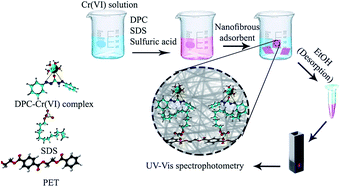Electrospun polyethylene terephthalate (PET) nanofibers as a new adsorbent for micro-solid phase extraction of chromium(vi) in environmental water samples†
Abstract
In this study, a polyethylene terephthalate (PET) nanofiber film was fabricated using a simple and low-cost electrospinning method and used as a novel adsorbent for solid phase microextraction (SPME) of chromium(VI) in water samples. 1,5-Diphenylcarbazide (DPC) as a selective complexing agent for Cr(VI) and sodium dodecyl sulfate (SDS) as a surfactant were added to sample solutions to improve the selectivity and sensitivity of the method. The extraction procedure was coupled with UV-Vis spectrophotometry for the determination of preconcentrated Cr(VI). The influence of the main parameters that affect the recovery of Cr(VI), including desorption conditions, pH, adsorbent dosage, adsorption time, and the concentration of DPC and SDS, were studied and optimized. The analytical figures of merit of the method were: the preconcentration factor, 125; the linear dynamic range, 1.8–60 ng mL−1; the determination coefficient (R2), 0.9923; the limit of detection (LOD), 0.6 ng mL−1, and the limit of quantification (LOQ), 1.8 ng mL−1. The relative standard deviations (RSDs%) for intra-day and inter-day assays were 1.6% and 3.1% (n = 3), respectively. The proposed method was successfully applied for the determination of Cr(VI) in natural water samples, and the relative recoveries in the range of 96.9–99.1% were obtained.


 Please wait while we load your content...
Please wait while we load your content...